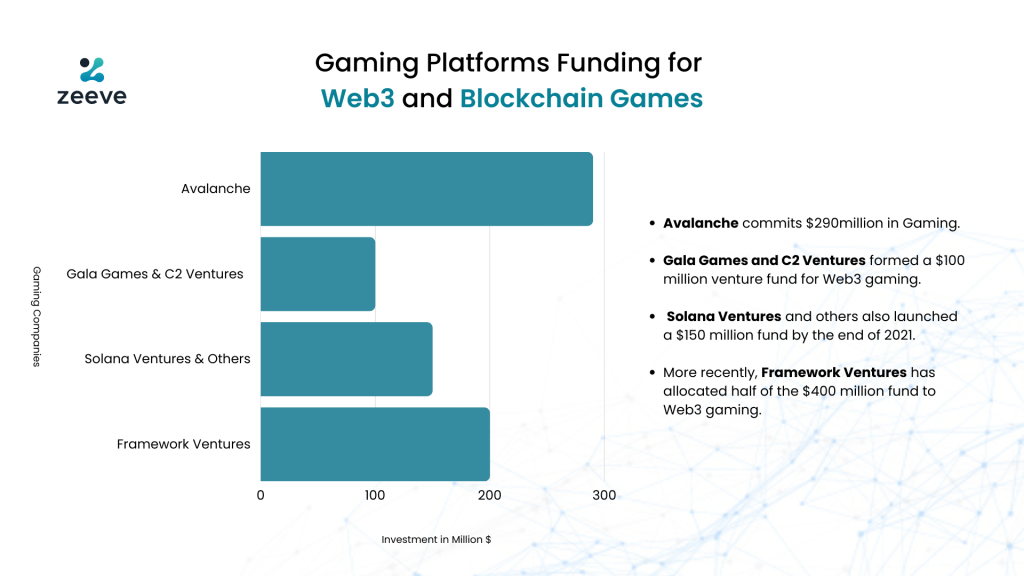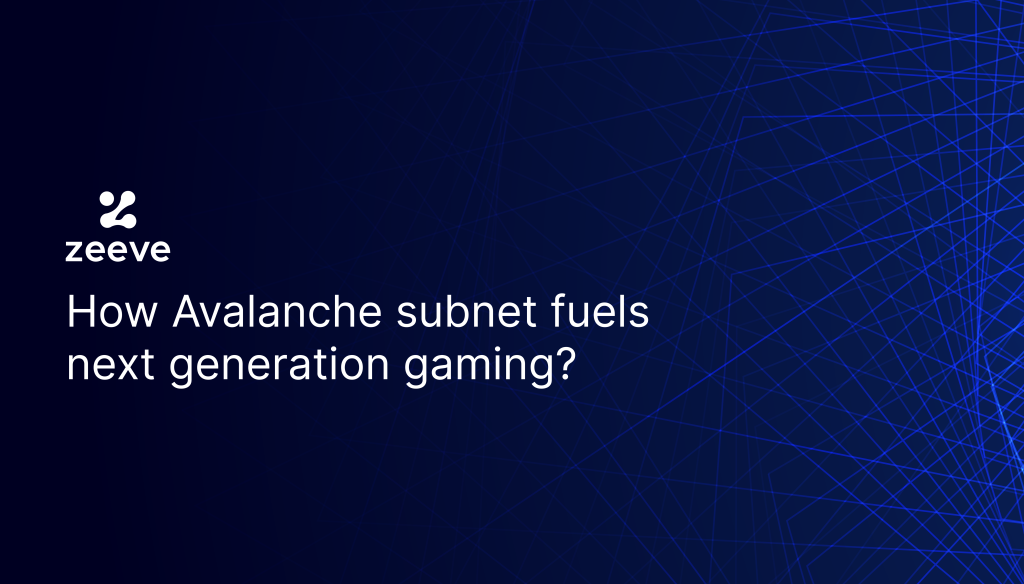In 2023, we will witness a new era of blockchain scaling along with Web3 gaming, predicts the experts in the market. Since the existing networks have high gas fees and low throughput, a rising number of enterprises prefer to choose Avalanche, largely for its myriad range of benefits. Avalanche has figured out a unique way to handle the high traffic that most gaming platforms experience and for which they fail to generate the desired user experiences. As a result of the Avalanche Network already in place, the L1s (Formerly known as Subnets) provide additional volume on the network. This is possible through the functioning of native gas tokens and a customized network. The Avalanche protocol is becoming increasingly popular due to its combination of scalability, enhanced functionality and speed of general transactions. It provides a fast, secure and efficient way to process gaming transactions. The protocol can handle large volumes of transactions simultaneously, making it an ideal network for gaming applications that require high throughput. Additionally, it provides improved security and reliability as compared to other protocols.
The network is passionate about its L1 (Formerly known as Subnets) and has a $290 million incentive program to speed up its adoption. The incentive program will accelerate the growth of the ecosystem. Further, there is tremendous support from Avalanche for Web3 games on their L1s, and it may bring a new wave to GameFi. There has been a 2000% growth in blockchain gaming in 2022, as per Blockchain Game Alliance and DappRadar. Thus, there is no doubt that Web3 gaming will be a big market in the next few years.
By using L1s (Formerly known as Subnets), it is possible to facilitate the integration of innovative technologies based on both consensus and horizontal scalability architectures. There have been many Web2 gaming companies moving towards the Web3 ecosystem, and L1s make the process easy. In this blog, we will understand more about the state of Avalanche L1 (Formerly known as Subnets), the games leveraging the platform and the reason behind what makes L1s different.
Overview of Avalanche L1s
L1s are quite similar to the sidechains, but they choose to employ the validators from the mainnet of a network. It is a portion of the network divided into many easy-to-manage units. Both the L1s (Formerly known as Subnets) and the sidechain are considered favorable by Web3 gaming companies. However, the issue with many of the existing networks is that they become congested due to play-to-earn (P2E) gaming.
The companies mainly opt for these to solve problems related to scalability, as an L2 scaling solution. Each L1 (Formerly known as Subnets) has five validators and can have around 10 for a better network and security. As a result of having their own L1s (Formerly known as Subnets), Web3 games have a greater degree of control over the predetermined parameters of the blockchain.
L1 (Formerly known as Subnets) is a sovereign network and has its own rules regarding membership. The validators on the network are also part of Avalanche’s primary network.
The L1s (Formerly known as Subnets) allows gaming institutions to migrate on-chain and experience the network as a user rather only as an investor. The regulated institutions are deploying the Avalanche for specific needs, which can be gaming or any other use cases as well. There is the availability of native KYC for the validators.
The Avalanche L1s in Gaming
The Ava Labs president in the Decrypt podcast explained more about how the L1s act as a white-label solution for any custom blockchain. The L1s work separately, still a part of Avalanche’s bigger network. Thus, use dApps like never before with the Avalanche L1s (Formerly known as Subnets). The ongoing developments in Game dApps have many exciting opportunities for gamers and gaming companies.
With the usage of L1 (Formerly known as Subnets) by chance, if a game on the platform is lagging, other games on the network won’t be affected. Due to the wide range of applications around every domain, the L1s (Formerly known as Subnets) are pushing fees to an all-time low, and the network traffic is hitting an all-time high.
The Avalanche L1s (Formerly known as Subnets) are helpful in interoperability with the broader ecosystem. The L1s (Formerly known as Subnets) give complete control over the creation of dApps. This comes along with a reduction in costs and time. Thus, making the platform well-suited for the gaming industry.

Games Leveraging the Avalanche L1
The Avalanche L1 (Formerly known as Subnets) gives the Web3 networks control over the blockchain network, and this is quite helpful for the rapid scaling of the user base without making any sacrifice on security.
State of Avalanche L1 gaming
The Avalanche gaming developers give more importance to the play-and-earn methods rather than the play-to-earn method. Therefore, in the play-and-earn, the major attention is on playing games for the immersive experience it provides. As the games keep on evolving, there isn’t any game that remains monetizable in the longer run. The play-and-earn focuses on the gameplay and the player experiences. Some of the notable games using Avalanche L1 (Formerly known as Subnets) are:
Crabada
The Crabada games allow users to experience faster gameplay and better game experience with Avalanche L1s (Formerly known as Subnets). The games allow the players to have in-game characters and trade and breed them. Moving to Avalanche’s Swimmer network, the game players witnessed an 85% reduction in fees.
DeFi Kingdoms
The gaming company launched its own L1 (Formerly known as Subnets) on Avalanche. Using vintage fantasy pixel imagery and utility-driven NFTs, the game blends the best of both worlds. The game is layered on top of DEX. The game’s chain is one of the major EVM L1s (Formerly known as Subnets) on Avalanche.
Ascenders
It is a fun adventure game with a fascinating storyline and graphics. The gaming platform collaborated with Avalanche L1 (Formerly known as Subnets) for its high throughput and sub-second finality. The game requires layer-1 support, and the L1 is ideal for modular scaling.
SnakeCity
SnakeCity is a vibrant GameFi project on Avalanche. Subsequently, with SnakeCity, Avalanche L1 (Formerly known as Subnets) is intended to promote wider adoption of Web3 gaming. The game is inspired by slither.io and is a P2E NFT game. As part of the game, SNCT tokens have real value and are redeemable for real money.
Gamestar+
Gamestar is a streaming platform and an interactive social game that has collaborated with Ava Labs. The reason to connect with the blockchain development company is to connect players, friends, and families around the world with robust smart contract functionality and high transaction throughput.
Why Gaming Platforms Choose Avalanche L1
Firstly, the gaming platforms are a fan of Avalanche L1s‘ (Formerly known as Subnets) sub-second finality. The sub-second finality is when transactions occur in less than a second. For any games out there, the transaction per second, time to finality, ease of development, and free gas fee for gamers is of utmost importance.
All the platforms largely agree that the Avalanche L1 (Formerly known as Subnets) gives the flexibility to build its own game environment and allow a custom gas fee structure. Additionally, the network portability allows the players to leverage an external NFT to mint gaming NFTs to create a new character. Other than great interoperability, scalability, and usability some of the specific advantages of L1 are:
Application Specific Blockchain (ASB)
The different L1 (Formerly known as Subnets) has certain hardware requirements, so the network doesn’t lag in performance. The L1s allow gaming projects to create ASBs. The specific blockchain doesn’t disturb the rest of the chain, and the game doesn’t use all the bandwidth.
NFT Creation
The Avalanche allows the NFT creation for P2E games. The ERC721 token can do the creation of NFT. The network has established a Blizzard Fund, investing $200 million in NFT initiatives.
Localized Network
The L1 (Formerly known as Subnets) allows the establishment of a localized chain which runs independently. Furthermore, the users can leverage their own token for the gas fee. The platform runs on independent token economics. Subsequently, there are fee markets that work on native tokens.
Compliance
The L1s’ (Formerly known as Subnets) architecture has a clear set of requirements for the validators. .Additionally, a validator who isn’t interested in validating certain blockchains can stay away from that chain. Thus, the L1s (Formerly known as Subnets) gives independence to the validators. The validators on L1 (Formerly known as Subnets) have to only look over the blockchain of their choice, which reduces the burden for them.
One of the challenges of L1s is they don’t have any Inter-Blockchain Communication protocol. This means the L1 will have to bridge with one another on a network less secure than IBC. In other words, the projects in the same L1 (Formerly known as Subnets) will share security.
Wrapping Up
You can understand more about the deployment of Avalanche L1s (Formerly known as Subnets) with Zeeve. The Avalanche industry is one of the fastest-growing smart contract platforms. There are many reasons to adopt the chain. From being environment-friendly to low-cost, the platform allows cross-chain processing and immense blockchain scalability.
The Avalanche is solving the blockchain trilemma by working attentively on its overall usage and development. As the L1s (Formerly known as Subnets) share security with Avalanche and thus enable all the transactions without any congestion. Not to mention, the gaming projects are going to increase in the coming years, and there are more than 10 games about to join the network.
Partner With Zeeve
Thinking about owning customizable blockchain networks which focus on gaming. Connect with Zeeve! With a solid vision to support the gaming and Web3 and blockchain-powered gaming economy, you can launch your Avalanche L1 (Formerly known as Subnets) with Zeeve. There will be cross-cloud deployment L1 automation and a GUI Dashboard to manage the network. We support bring your own cloud (BYOC) for Avalanche L1s and other networks as well.
Many of the influential organizations trust Zeeve to manage their Blockchain Infrastructure Management Platform & we’d be delighted to work with your enterprise as well. To learn more about Zeeve, feel free to connect with us on Twitter and Telegram. For further details, schedule a call with us.






















